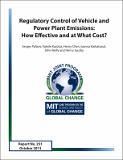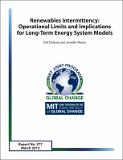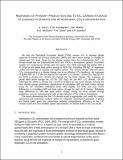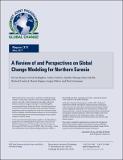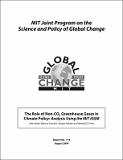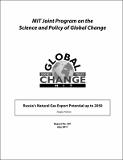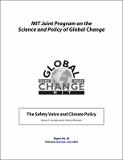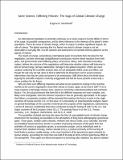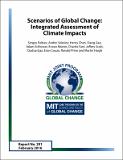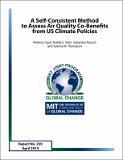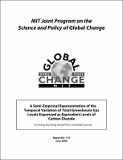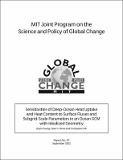Browsing Joint Program on the Science and Policy of Global Change Reports by Title
Now showing items 260-279 of 329
-
Regulatory Control of Vehicle and Power Plant Emissions: How Effective and at What Cost?
(MIT Joint Program, 2013-10)Passenger vehicles and power plants are major sources of greenhouse gas emissions. While economic analyses generally indicate that a broader market-based approach to greenhouse gas reduction would be less costly and more ... -
Relative role of changes in CO₂ and climate to equilibrium responses of net primary production and carbon storage of the terrestrial biosphere
(MIT Joint Program on the Science and Policy of Global Change, 1996-06)In a partial factorial model experiment, we used the Terrestrial Ecosystem Model (TEM, version 4.0) to assess the relative roles of changes in CO2, temperature, precipitation and cloudiness in equilibrium responses of ... -
Relative Roles of Climate Sensitivity and Forcing in Defining the Ocean Circulation Response to Climate Change
(MIT Joint Program on the Science and Policy of Global Change, 2007-05)The response of the ocean’s meridional overturning circulation (MOC) to increased greenhouse gas forcing is examined using a coupled model of intermediate complexity, including a dynamic 3D ocean subcomponent. Parameters ... -
Renewables Intermittency: Operational Limits and Implications for Long-Term Energy System Models
(MIT Joint Program on the Science and Policy of Global Change, 2015-03)In several regions of the world, the share of intermittent renewables (such as wind and solar PV) in electricity generation is rapidly increasing. The current share of these renewable energy sources (RES) can still more ... -
Representing energy technologies in top-down economic models using bottom-up information
(MIT Joint Program on the Science and Policy of Global Change, 2002-10)This paper uses bottom-up engineering information as a basis for modeling new technologies within the MIT Emissions Prediction and Policy Analysis (EPPA) model, a computable general equilibrium model of the world economy. ... -
Responses of primary production and total carbon storage to changes in climate and atmospheric CO₂ concentration
(MIT Joint Program on the Science and Policy of Global Change, 1995-10)The authors used the terrestrial ecosystem model (TEM, version 4.0) to estimate global responses of annual net primary production (NPP) and total carbon storage to changes in climate and atmospheric CO2, driven by the ... -
Rethinking the Kyoto emission targets
(MIT Joint Program on the Science and Policy of Global Change, 2000-08) -
The Revenue Implications of a Carbon Tax
(MIT Joint Program on the Science and Policy of Global Change, 2017-07)A primary reason for implementing a carbon or greenhouse gas tax is to reduce emissions, but in recent years there has been increased interest in a carbon tax’s revenue potential. This revenue could be used for federal ... -
A Review of and Perspectives on Global Change Modeling for Northern Eurasia
(MIT Joint Program on the Science and Policy of Global Change, 2017-05)Northern Eurasia is made up of a complex and diverse set of physical, ecological, climatic and human systems, which provide important ecosystem services including the storage of substantial stocks of carbon in its terrestrial ... -
The Role of China in Mitigating Climate Change
(MIT Joint Program on the Science and Policy of Global Change, 2012-04)We explore short- and long-term implications of several energy scenarios of China’s role in efforts to mitigate global climate risk. The focus is on the impacts on China’s energy system and GDP growth, and on global climate ... -
The Role of Non-CO2 Greenhouse Gases in Climate Policy: Analysis Using the MIT IGSM
(MIT Joint Program on the Science and Policy of Global Change, 2004-08)First steps toward a broad climate agreement, such as the Kyoto Protocol, have focused attention on agreement with less than global geographic coverage. We consider instead a policy that is less comprehensive in term of ... -
Russia's role in the Kyoto Protocol
(2003-06)As a result of the allocation of emissions reductions, and the differential willingness of countries to ratify, it turns out that Russia is a central player in the Kyoto Protocol. With the U.S. out and Japan and the EU ... -
Russia’s Natural Gas Export Potential up to 2050
(MIT Joint Program on the Science and Policy of Global Change, 2011-07)Recent increases in natural gas reserve estimates and advances in shale gas technology make natural gas a fuel with good prospects to serve a bridge to a low-carbon world. Russia is an important energy supplier as it holds ... -
The safety valve and climate policy
(MIT Joint Program on the Science and Policy of Global Change, 2002-02)In discussions of a cap-and-trade system for implementation of Kyoto Protocol-type quantity targets, a "safety valve" was proposed where, by government sales of emissions permits at a fixed price, the marginal cost of the ... -
Same science, differing policies : the saga of global climate change
(MIT Joint Program on the Science and Policy of Global Change, 1997-08)This paper provides a comparative analysis of the economic and political interests influencing the progress of climate negotiation. The primary focus is on the U.S., France, Germany, U.K., Belgium, Netherlands, and the ... -
Scaling Compliance with Coverage? Firm-level Performance in China’s Industrial Energy Conservation Program
(MIT Joint Program on the Science and Policy of Global Change, 2016-10)Industrial energy conservation programs in China form a cornerstone of China’s energy and environmental management efforts, engaging thousands of major energy-using enterprises, and targeting hundreds of million tons of ... -
Scenarios of Global Change: Integrated Assessment of Climate Impacts
(MIT Joint Program on the Science and Policy of Global Change, 2016-02)Using the MIT Integrated Global System Modeling (IGSM) framework, we assess the climate impacts of emission scenarios exhibiting global mean surface temperatures ranging between 2.4°C and 4.3°C above pre-industrial by 2100. ... -
A Self-Consistent Method to Assess Air Quality Co-Benefits from US Climate Policies
(MIT Joint Program on the Science and Policy of Global Change, 2014-04)Air quality co-benefits can potentially reduce the costs of greenhouse gas mitigation. However, while many studies of the cost of greenhouse gas mitigation model the full macroeconomic welfare impacts, most studies of air ... -
A semi-empirical representation of the temporal variation of total greenhouse gas levels expressed as equivalent levels of carbon dioxide
(MIT Joint Program on the Science and Policy of Global Change, 2009-06)In order to examine the underlying longer-term trends in greenhouse gases, that are driven for example by anthropogenic emissions or climate change, it is useful to remove the recurring effects of natural cycles and ... -
Sensitivities of deep-ocean heat uptake and heat content to surface fluxes and subgrid-scale parameters in an ocean GCM with idealized geometry
(MIT Joint Program on the Science and Policy of Global Change, 2002-09)Sensitivities of the net heat flux into the deep-ocean (Qnet) and of the deep-ocean heat content (DOC) below 700 m are studied using an ocean general circulation model and its adjoint. Both are found to have very similar ...

